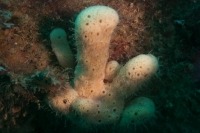
(Photo: Claire Goodwin)
Deichmann's Sponge
Isodictya deichmannae
Yellow or orange sponge often with many branches. The branches may be large, flattened lobes or more cylindrical. Large oscules are visible along their length. Individuals can reach over 20 centimetres in height.
Authority
de Laubenfels, 1949
Classification Details
Phylum: Porifera (sponges); Class: Demospongiae (siliceous sponges).
Habitat
Found growing on bedrock. Distributed over the east coast of North America from New England to the Gulf of Saint Lawrence.
Diet
Sponges feed on small particles in the seawater. 80% of their diet is bacteria-sized particles (<0.5 micrometres in diameter). They suck seawater into a network of canals in their body using a current generated by cells called choanocytes. The choanocytes also capture the food particles.
Reproduction
Hermaphrodite – individuals are both male and female. Sperm is released into the water column, then sucked up by another sponge and used to fertilize its eggs. The sponge then broods the resulting embryos in its body tissue until they develop into free-swimming larvae that are released into the seawater. After a few days in the seawater, the larvae settle and develop into adult sponges.
Fun Facts
This species was described from specimens found near Woods Hole, Massachusetts. It was named after Elisabeth Deichmann who was a marine zoologist at Harvard University.
References
de Laubenfels MW (1949) The sponges of Woods Hole and adjacent waters. Bulletin of the Museum of Comparative Zoology at Harvard College. 103, 1–55. Maldonado M (2006) The ecology of the sponge larva. Canadian Journal of Zoology 84, 175–194.

